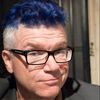Unlike every art pundit phoning in an internet review of George Bush's painting exhibition in Dallas, I actually flew down to the Big D last week to see them for myself. The exhibition is at his presidential library on the SMU campus. I had lunch at Cafe 43 there to start my visit and then paid the $16 admission price to gain entry.
The exhibit is unpretentiously laid out with Bush's portraits of world leaders hanging amidst placards recounting the visits Bush had with each leader and vitrines containing gifts these visitors bought along for George and Laura. Perhaps you never thought much about gift giving at the higher levels of power, but a show devoted solely to all this loot would be interesting. It would have been more interesting to look at the paintings in a more conventional art setting -- white walls in clean, well lit spaces with unimpeded views of the paintings hung uniformly on a centerline of 57 inches. I desperately wanted to see an indication of the chronological order in which these works were painted; it would have indicated the progress of Bush as a painter.
The quality of the works varies greatly. His Dalai Lama portrait is slap-dash terrible while the painting of Indian Prime Minister Manmohan Singh is so inventive that it is just too advanced for a novice. And of course, the thoroughly topical masterpiece of the exhibit -- Vladimir Putin's palpably evil stare. Knowing when exactly Bush painted this picture would have added much to the understanding of him developing as a painter. It may have also revealed any prescience in knowing if the Russian dictator was headed toward his recent diabolical expansion.
But the layout of the paintings adopted no pretense of fine art display conventions. They hung on a dark blue wall amidst the clutter of text passages, photographs and all that ornate loot behind plexi display cases. Some were at eye level, others loomed above cases and, as the exhibit progressed, groups of four appeared, the occasional improper glare of track lighting bouncing back.
In art world short-hand Bush's paintings can be described like this: Imagine the love child of David Hockney and Alice Neel mentored in painting by Luc Tuymans. But the show had zero pretense of being presented in a traditional art setting. The curation announced that the art world is not Bush's intended audience. It brought back memories of a totally different artist...
The whole installation bordered on the tacky when it suddenly reminded me of visits to Thomas Kinkade stores back at the turn of the millennium. Nothing was a better hoot back in the day than a visit to a licensed franchisee gallery showing the giclees of the Kinkade machine. Every work revealed the charming aspirations of middle America turned maudlin by the dramatic addition of a lone spotlight splayed across a simpleton scenic canvas. The dark walls, the heraldic framing, the implied investment value -- it was a pageant of every signifier of art with none of the challenges with which great art confronts its viewers and its times. Nothing summed up the soulless center of suburban American culture more -- it was of its time.
Rewind the clock fourteen years -- George Bush was the president of the United States and the most popular artist in the country was Thomas Kinkade. Both were sentimentalists deemed cloying by their opposition. Each was either oblivious to criticism or disinterested as their styles were strictly about engaging the public without pretense or any accommodations that modernity had ever occurred. In policy and paint-stroke they pined for a yesteryear that was constructed on what their audience saw as lacking in the present day. At the core of each man's approach was an engineered simplicity to re-establish their audience's collective agreement about what yesteryear had delivered.
But their personal journeys now seem to be eerily opposite. Thomas Kinkade evolved from an earnest art student to a much-mocked but successful careerist who incorporated Christian beliefs into his art only to see a slide into alcohol tarnish his legacy and cut short his life. Meanwhile George Bush had a silver spoon party boy legacy altered by discovering Christ, sobering up, going on to a much-mocked but two term presidency and is now seen as an earnest painter.
So how does the painting of an American political conservative leader stack up against the most popular conservative American painter since Norman Rockwell?
Kinkade's signature work invokes a rigid realism that Bush seems to aspire toward. While a painter can be trained, an artist must be born at some point in the process. Kinkade never deviated from the most predictable compositions and leaned heavily on the techniques of nineteenth century classical landscape painters. Bush is far more complex. He has been quoted as approaching his painting teacher with the self-assurance that "there is a Rembrandt in me trying to break out." He hasn't gotten there yet but he has developed a consistent visual vocabulary that has more hallmarks of originality than decades worth of Kinkades.
Bush paints with an economy of means, rarely building up any paint above the surface. He avoids the ultimate trope of the novice -- symmetry. His subjects all have distinctive facial structure where most amateurs plot out faces on a grid. Bush's limitations are in not mastering the layering that oil paint requires of those seeking realism This is where Kinkade runs circles around the former President. But Kinkade's mastery of technique ends at technique. Einstein said imagination was more important than knowledge and in art an imaginative application of one's medium always trumps the systematic conventions of copycats. Thomas Kinkade is a better technical PAINTER than George Bush, but in his inventive quest to develop a visual vocabulary that captures an emotional recollection of the world leaders with whom he bonded, George Bush is already a far superior ARTIST to Thomas Kinkade.
